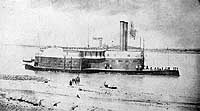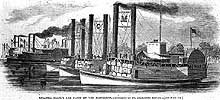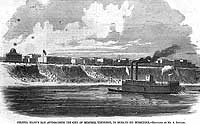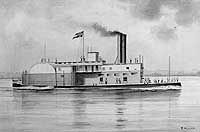
A "Ram" is a ship whose principal weapon is its own bow, hardened and reinforced to penetrate the hull of an enemy ship, and usually strengthened internally to avoid or reduce self-inflicted damage from the collision. Rams had a long history of success during the age of oared fighting ships, which could maneuver at will, and were particularly suitable for combat in coastal and inland waters.
The ram was impractical on sailing ships, which were less maneuverable and encumbered by extensive masts and rigging, but steam propulsion brought it back into favor. During the American Civil War, the Confederacy made extensive use of the ram, both on specialist ships and on ironclads that also carried heavy gun armament. Some conventional Union warships were modified for ramming and the North also employed a modest number of specialist rams in the Mississippi River area. These included the "Ellet Rams", which were Army ships that cooperated with the Navy, several rams captured from the Confederates, and two ships (Avenger and Vindicator) constructed for the Army but turned over to the Navy before completion in 1864.
Though subsequent events showed the ram to be a difficult weapon to use effectively and all too likely to harm friends more than foes, the incidents of the Civil War and the 1866 war between Austria and Italy kept it in favor beyond the end of the 19th Century. Though the ram was usually fitted as an auxiliary weapon on ships mainly armed with guns, the U.S. Navy did build one specialist ram ship in the 1890s, USS Katahdin. During the two World Wars, the ram enjoyed a brief revival when many destroyers and other smaller warships were given specially hardened bows to attack surfaced submarines.
I. Commissioned U.S. Navy Rams (or ships that had been rams in Confederate service before entering the U.S. Navy).
II. The "Ellet Rams".
In March 1862, the U.S. Army authorized the noted civil engineer Charles Ellet, Jr., to establish a flotilla of steam rams for employment on the Western Rivers. Ellet converted several powerful river towboats, heavily reinforcing their hulls for ramming. These ships had light protection for their boilers and upperworks, but were originally given no artillery. With the rank of Colonel, Ellet led his force in action during the Battle of Memphis on 6 June 1862, where rams played an important role in the Union victory against the Confederate River Defense Fleet. However, Colonel Ellet died several days later of a wound received at that action.
Alfred Ellet, Charles Ellet's brother, then took command of the rams. Under his leadership, the rams figured prominently in actions around and below Vicksburg into 1863. Ellet's ram fleet was technically owned and operated by the Army even after the transfer of the Western Gunboat Flotilla to the Navy and was always somewhat independent of Navy command. After the threat of Confederate warships declined, it was reorganized as the Mississippi Marine Brigade, employing its ships and troops for amphibious operations. The Ellet fleet was disestablished in August 1864, and its surviving ships were transferred to other duties.
The "Ellet Ram Fleet" included the following ships:
In addition to the descriptions and links provided above, this page provides views of ships that are (or probably are) units of the "Ellet Ram Fleet".
| If you want higher resolution reproductions than the digital images presented here, see: "How to Obtain Photographic Reproductions." |
Click on the small photograph to prompt a larger view of the same image.
|
Photo #: NH 59007 "Colonel Ellet's Ram Fleet on the Mississippi" Line engraving after a sketch by Alexander Simplot, published in "Harper's Weekly", 1862. Ships in the foreground are: Monarch (letter "M" between stacks), Queen of the West (with letter "Q") and Lioness(letter "L"). In the left background are: Switzerland (with letter "S" on paddlebox), Samson and Lancaster. Note cotton bales stacked on deck to protect boilers. U.S. Naval Historical Center Photograph. Online Image: 123KB; 740 x 360 pixels |
 |
|
Photo #: NH 59055 "Colonel Ellet's Ram Approaching the City of Memphis, Tennessee, to Demand its Surrender." Line engraving after a sketch by Alexander Simplot, published in "Harper's Weekly", 1862, depicting an incident at the close of the Battle of Memphis on 6 June 1862. The steamer shown may be Mingo or Lioness, the stern-wheel rams of Ellet's fleet. U.S. Naval Historical Center Photograph. Online Image: 130KB; 740 x 485 pixels |
 |
|
Photo #: NH 53868 One of the "Ellet Rams" Photograph of a Civil War Western Rivers ram steamer. This view was originally identified as USS General Price, but differs from that ship in many basic features. Instead, this is most probably one of the Ellet fleet's side-wheel rams, which included: Switzerland, Queen of the West, Monarch, and Lancaster. U.S. Naval Historical Center Photograph. Online Image: 93KB; 740 x 435 pixels |
 |
|
Photo #: NH 55834 One of the "Ellet Rams" (under false colors!) Sepia wash drawing by F. Muller, circa 1900. This painting, based on Photo # NH 53868, suffers from that photograph's original incorrect identification. Intended by the artist to depict the Confederate ram steamer General Sterling Price, and featuring the Confederate flag, it instead represents one of the U.S. ram steamers of the Ellet fleet. Only one of the "Ellet Rams", Queen of the West, saw Confederate service, and she did not look like the ship depicted here. Courtesy of the U.S. Navy Art Collection, Washington, D.C. U.S. Naval Historical Center Photograph. Online Image: 81KB; 740 x 515 pixels |
 |
| If you want higher resolution reproductions than the digital images presented here, see: "How to Obtain Photographic Reproductions." |
Page made 21 March 2000
Coding updated 26 March 2001